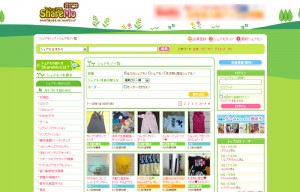Sharemo: social sharing service
What is Sharemo?
Sharemo is Japanese ingenuity at its best. It’s a new kind of website, dubbed “social sharing“, where people can list things they have but don’t need around the house, and borrow or take similarly listed items from other people across the country.
Sharemo homepage
Every item sent through Sharemo is paid for on delivery, so you only pay for what’s shipped to you. There aren’t even any fees to sign up. Interested yet? I thought so…
This almost sounded too good to be true, so I decided to sign up and check it out for myself. Here’s what I discovered…
What do you need to sign up?
- a Japanese physical address
- a Japanese mobile phone email address
- some knowledge of Japanese language or a Japanese friend
- The website is in Japanese only.
- about 5 minutes
Sharemo works as advertised
I quickly set out to find a couple small items to test the service. After browsing through a small selection of Sharemo’s more than 35000 listed items, I eventually selected this Nintendo DS game and a couple of Haruki Murakami books. I requested the items through the Sharemo website on a Saturday night, received shipment notifications (that told me how much shipping would cost) on Monday (for the DS game) and Tuesday (for the Murakami books), and the items arrived at the time I requested (9~12AM) on Tuesday and Thursday, respectively. Fabulous!
Each item you borrow from someone on Sharemo has a share period (シェア
In addition, if you are “borrowing” from someone in the same city as you (or somewhere close), you can even privately arrange with the current holder to go pick up the item yourself or meet somewhere and exchange, which will save you the shipping fee. Some people will contact you after you make the order and suggest different shipping methods to try and save you some money.
What’s available on Sharemo?
There’s a lot of junk on Sharemo, to be honest. Used baby clothes, AV cables for your TV and so on. You know, the kind of stuff that’s left over at the end of a garage sale. But everything is nicely categorized so you can find something you want fairly easily. Personally, I think Sharemo is most useful as a resource for finding…
- Video games
- DVD movies
- Books & manga
- Kitchenware
- Small appliances
But you can also get things like used clothing, musical instruments and sporting goods. Here’s a sample listing and a part-by-part translation (click to enlarge the picture if you can’t read the numbers).
Listing Translation
- suihanki = rice cooker
- This is the title for the item listing.
- furi- = free/available
- This is the status of the item.
- There are 4 different statuses:
- Available (フリー/furi-),
- Being Shared (シェア
中 /shea chuu), - Take only (
引 き取 り限定 /hikitori gentei) - Retired (
引退 /intai).
- Listing period.
- How long the item will be listed on Sharemo for before it is retired, the original owner chooses this when they list (or as they say on Sharemo, when you “デビュー = debut”) an item.
- shea ninzuu = number of sharers
- The number of people that have shared the item so far.
- kategori- = item category
- In this case: Appliances/AV/PC > Household > Kitchen
- shea taishou = share target
- People can specify a minimum R-point class for an item, either to add some assurance that the persons borrowing are reliable Sharemo users or just simply as a kind of reward for other good sharers.
- shea kikan = share period
- How long you will be able to have the item before it can be requested by the next Sharemo user.
- Item options
引 き取 り/hikitori = Take —不可 /fuka = Not allowed入 れ替 え/irekae = Trade-in — NG = No good (not possible)- For multiple items being shared as a set, this is an option for you to keep one of the original items, replacing it with a similar item of your own. (good for clothes, maybe? hmmm…)
付 け足 し/tsuketashi = Add-in — NG = No good (not possible)- For an incomplete collection of items (ie. a manga series that is missing a volume or two), this indicates whether sharers are allowed to add the missing parts if they have it.
- o-da- suru = place order
- The button is deactivated because we don’t have enough R-points (see #6)
- sheamono ID = Share Item ID
- joutai = Condition
- Whether the item is in good condition, damaged or broken.
You can also find consumable items like cosmetics or food and drink. And there’s even a category just for pet food (?!). (Note: most consumable items listed on Sharemo are typically “take only” items, not to be returned or passed on.)
Can’t find what you want? Well that’s okay, there’s a request board where you can ask for someone to list a specific item for you! The guys at Sharemo really thought this out pretty well.
Get free stuff (and keep it too!)
Listing, borrowing, and sending items on Sharemo all accrue “R” points. Members who have been using the service for a long time and who have saved up many points have access to a wider selection of items to borrow.
But members can also use their Sharemo R-points as a kind of currency to “take” items from other people. These “take only” items (listed as
From what I’ve seen of the items so far, most of the “take only” items are available for 100-500 points, which is not that much considering you get 500 points for signing up or listing an item and 100 points for passing on a borrowed item. You also get points for things like logging in and commenting on an item.
Get rid of your junk
Well, not everything is easy to get rid of, even on Sharemo. People probably won’t want to pay the shipping cost to borrow or even take your stinky old refrigerator, but if you’ve got lots of old books, small kitchen appliances, computer peripherals and old clothes that are cluttering up your tiny Japanese apartment, then this is a good option for you.
Worried about shipping?
If you’re just starting with the service, there’s an element of uncertainty about the shipping aspect of Sharemo. How much will it cost? How long will it take? What if I’m not home when the item arrives? How do I send to the next person when they ask for it? Well worry not, I tested the waters myself and all is safe.
Cost is I think just about what you would expect. Delivery of the Nintendo DS game I borrowed was 600 yen and the two small Murakami books were also 600 yen shipped together. For the books it might have been cheaper just to buy them used at one of Japan’s many used book stores but oh well. I think my next test will be to borrow a coffee maker and see how much that costs to deliver. I’ll be sure to add that information into this article later.
As for delivery time, once an item is in the mail system it takes only a day or two to arrive, and you specify a desired delivery time when you request the item. But the catch is you never know how long it will take the sender to actually get around to mailing it. This isn’t really a problem though as my (limited) experience is that people are very timely with their shipments. Japanese are typically very responsible which is part of the reason a site like this actually works.
If you’re not home when your COD (
To send your shared item out again, simply put it in an envelope, box, bag or whatever the thing fits in and take it to the post office. Tell them you want to send it via 「ゆうパック
The history of Sharemo
Apparently Sharemo has been around for some time on the Japanese mobile web, but it opened its service up to more users with a standard desktop-browser website this Summer. At the time of this article they were still running their grand opening campaign which gives users 500 R for signing up.
Sharemo is owned by Enigmo Inc., a Tokyo company focused on internet shopping and marketing services.
Relevant links
- Sharemo website
- Enigmo website (English)
- Official Sharemo English-language profile page
- My profile on Sharemo!
- Sharemo on Twitter (though they never tweet…)
- A smaller, older article on Sharemo at Techcrunch
Okay, that’s a wrap. Happy sharing, everyone! Let me know if you find anything interesting ![]()












Hmmm….. I need to move out of my apartment in April… I may just list the entire contents of said apartment on Sharemo…
by: Joshua Zimmerman, Nov 12th at 12:29 am
Your apartment wouldn’t happen to contain a PS3 and high definition TV by any chance, would it? I still need to gear up for FFXIII
I still need to gear up for FFXIII
by: Lloyd Vincent, Nov 14th at 10:17 pm